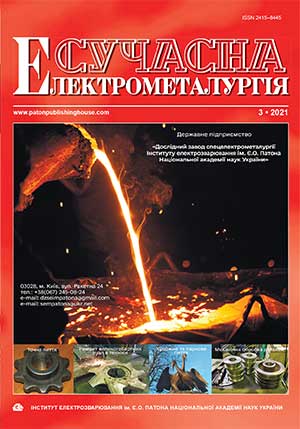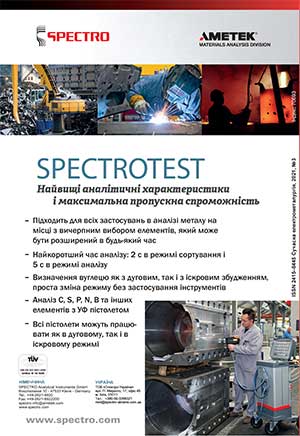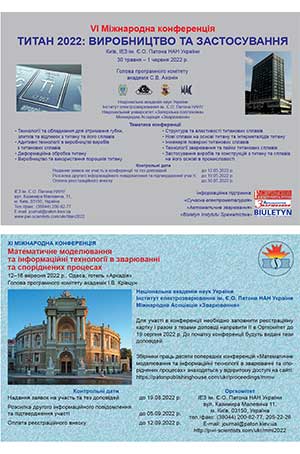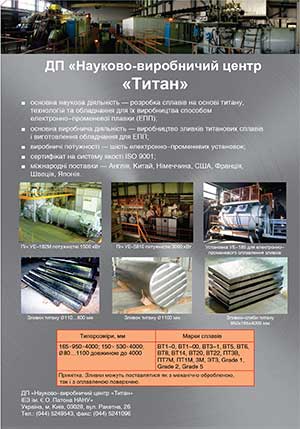| 2021 №03 (05) |
DOI of Article 10.37434/sem2021.03.06 |
2021 №03 (07) |
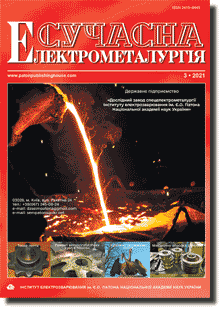
"Suchasna Elektrometallurgiya" (Electrometallurgy Today), 2021, #3, 35-41 pages
Structure and fracture mode of haz metal of corrosion-resistant 06G2BDP steel
O.M. Berdnikova, V.D. Poznyakov, V.A. Kostin, T.O. Alekseenko, S.L. Zhdanov, E.V. Polovetskyi
E.O. Paton Electric Welding Institute of the NAS of Ukraine. 11 Kazymyr Malevych Str., Kyiv, 03150, Ukraine. E-mail: office@paton.kiev.ua
Abstract
ВThe regularities of the influence of thermal cycles of welding on structural-phase transformations in the HAZ metal of 06G2BDP steel, on parameters of the structure forming in the metal at different cooling rates (w6/5 from 1 to 64 °с/s), and on its mechanical properties and fracture mode at static and dynamic loading were studied. Structural-phase transformations were investigated on model samples-simulators in Gleeble 3800 complex. The methods of light and scanning electron microscopy were used to determine the structural parameters, namely grain size, microhardness, as well as the features of the fracture mode. It is shown that base metal of 06G2BDP steel has a fine-grained ferrite-carbide structure; after impact bend testing the sample fracture demonstrates a ductile mode that ensures not only its high level of mechanical properties, but also the required crack resistance. Depending on the metal cooling rate, in the HAZ overheated zone its structure can change from ferritic-pearlitic (at w6/5 = 1 °с/s) to bainitic (at w6/5 = 20 °с/s) and bainitic-martensitic one (at w6/5 ≥ 20 °с/s). With increase of the cooling rate, the quantity of lower bainite in the metal becomes greater and refinement of the packet and lath substructures takes place, leading to increase of microhardness level and, consequently, to higher strength characteristics of HAZ metal of 06G2BDP steel at preservation of its ductility properties. Ref. 19, Tabl. 1, Fig. 6.
Keywords: high-strength corrosion-resistant steel; simulation of welding thermal cycles; cooling rate; heat-affected zone; microstructure; mechanical properties; fracture mode
Received 20.05.2021
References
1. Gorynin, I.V. (1980) Welded high-strength hull plates and their application. In: Modern problems of welding and special electrometallurgy. Kiev, Naukova Dumka, 120-131 [in Russian].2. Goldshtejn, M.I., Grachev, S.V., Veksler, Yu.G. (1985) Special steels. Moscow, Metallurgiya [In Russian].
3. Laukhin, D., Beketov, O., Rott, N., Schudro, A. (2019) The elaboration of modernized technology of controlled rolling directed at the formation of high strengthening and viscous qualities in HSLA steel. Solid State Phenomena, 291, 13-19. https://doi.org/10.4028/www.scientific.net/SSP.291.13
4. Kovtunenko, V.A., Gerasimenko, A.M., Sineok, A.G. (2004) High-strength sparcely-alloyed steel 06G2B with σy ≥ 440 MPa for bridge engineering. Avtomobilni Dorogy i Dorozhnie Budivnytstvo, 69, 106-113 [in Russian].
5. Sineok, A.G., Gerasimenko, A.M., Ryabokon, V.D. et al. (1014) Weather-resistant roll stock of C355-500 strength class for metal structures of bridges. Mosty i Tonneli: Teoriya, Issledovaniya, Praktika, 5 [in Russian].
6. Zavdoveev, A.V., Poznyakov, V.D., Zhdanov, S.L. et al. (2020) Impact of thermal cycles of welding on formation of the structure and properties of corrosion-resistant steel 06G2BDP. The Paton Welding J., 9, 14-18. https://doi.org/10.37434/tpwj2020.09.02
7. Paton, B.E. (2008) Selected works. Kiev, PWI [in Russian].
8. (2018) Materials science, achivements, prospects. Ed. by L.M. Lobanov. Kyiv, Akademperiodyka, Vol. 2 [in Ukrainian].
9. Grigorenko, G.M., Kostin, V.A., Orlovsky, V.Yu. (2008) Current capabilities of simulation of austenite transformations in low-alloyed steel welds. The Paton Welding J., 3, 22-24.
10. Gajvoronsky, A.A., Poznyakov, V.D., Sarzhevsky, V.A. et al. (2010) Influence of thermodeformational cycle of hardfacing on the structure and properties of railway wheels at their reconditioning. Ibid., 5, 15-19.
11. Cherepin, V.T. (1968) Experimental engineering in physical metals science. Kyiv, Tekhnika [in Russian].
12. Farber, V.M., Belenky, B.Z., Goldshtejn, M.I. (1975) Evaluation of strength of low-carbon low-alloy steels by structural data. Fizika Metallov i Metallovedenie, 3(2), 403-409 [in Russian].
13. Eshbi, I.F. (1972) About Orowan stress.In: Physics of strength and plasticity. Moscow, Metallurgiya, 88-107 [in Russian].
14. Armstrong, R.V. (1973) Strength properties of metals with ultrafine grain in metals. Moscow, Metallurgiya, 11-40 [in Russian].
15. Romaniv, O.N. (1979) Fracture toughness of structural steels. Moscow, Metallurgiya [in Russian].
16. Maksymov, S.Yu., Berdnikova, о.М., Prilipko, O.O. et al. (2021) Influence of external electromagnetic field on parameters and defects of crystal lattice of metal of welded joints during underwater welding. The Paton Welding J., 1, 23-28. https://doi.org/10.37434/as2021.01.06
17. Koneva, N.A., Lychagin, D.V., Teplyakova, L.A. et al. (1986) Dislocation-disclination substructures and strengthening. In: Theoretical and experimental study of disclinations: Transact. Leningrad, LFTI, 116-126 [in Russian].
18. Ivanova, V.S., Gordienko, L.K., Geminov, V.N. (1965) Role of dislocations in strengthening and destruction of metals. Moscow, Nauka [in Russian].
19. Balter, M.A., Lyubchenko, A.P., Aksyonova, S.I. (1987) Fractography as a mean of diagnostics of brocken parts. Moscow, Mashinostroenie [in Russian].

